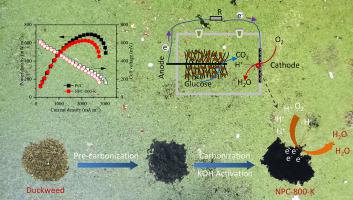International Journal of Hydrogen Energy ( IF 8.1 ) Pub Date : 2020-05-06 , DOI: 10.1016/j.ijhydene.2020.03.177 Xiaobo Gong , Lin Peng , Xinghong Wang , Lili Wu , Yong Liu

|
Cost-effective metal-free electrocatalysts for oxygen reduction reaction were incredible significance of improvement about microbial fuel cells. In this research, a novel nitrogen self-doped porous carbon material is effectively inferred with KOH activation from a natural and renewable biomass, duckweed. Self-doped nitrogen in carbon matrix of nitrogen-doped porous carbon at 800 °C provides abundant active sites for oxygen reduction and improves the oxygen reduction kinetics significantly. Moreover, the porous structure of nitrogen-doped porous carbon at 800 °C encourages the transition of electrolyte and oxygen molecules throughout the oxygen reduction reaction. Oxygen on the three-phase boundary is reduced to water according to a four-electron pathway on nitrogen-doped porous carbon electrocatalyst. The single-chamber microbial fuel cell with nitrogen-doped porous carbon as electrocatalyst achieves comparable power density (625.9 mW m−2) and better stability compared to the commercial Pt/C electrocatalyst. This simple and low-cost approach provides a straightforward strategy to prepare excellent nitrogen-doped electrocatalyst derived from natural and renewable biomass directly as a promising alternate to precious platinum-based catalysts in microbial fuel cells.
中文翻译:

浮萍衍生的氮自掺杂多孔碳材料,作为微生物燃料电池中氧还原反应的经济有效的电催化剂
具有成本效益的无金属氧还原反应电催化剂对于微生物燃料电池的改进具有不可思议的意义。在这项研究中,一种新型的氮自掺杂多孔碳材料可通过天然和可再生生物量浮萍的KOH活化来有效推断。氮掺杂多孔碳在800°C的碳基质中自掺杂氮为氧还原提供了丰富的活性位点,并显着提高了氧还原动力学。此外,氮掺杂的多孔碳在800°C时的多孔结构促进了整个氧还原反应中电解质和氧分子的过渡。根据氮掺杂的多孔碳电催化剂上的四电子路径,三相边界上的氧气被还原为水。-2)和比市售Pt / C电催化剂更好的稳定性。这种简单且低成本的方法提供了一种直接的策略,可以直接从天然和可再生生物质中制备出色的氮掺杂电催化剂,作为微生物燃料电池中贵重的铂基催化剂的有前途的替代品。


















































 京公网安备 11010802027423号
京公网安备 11010802027423号